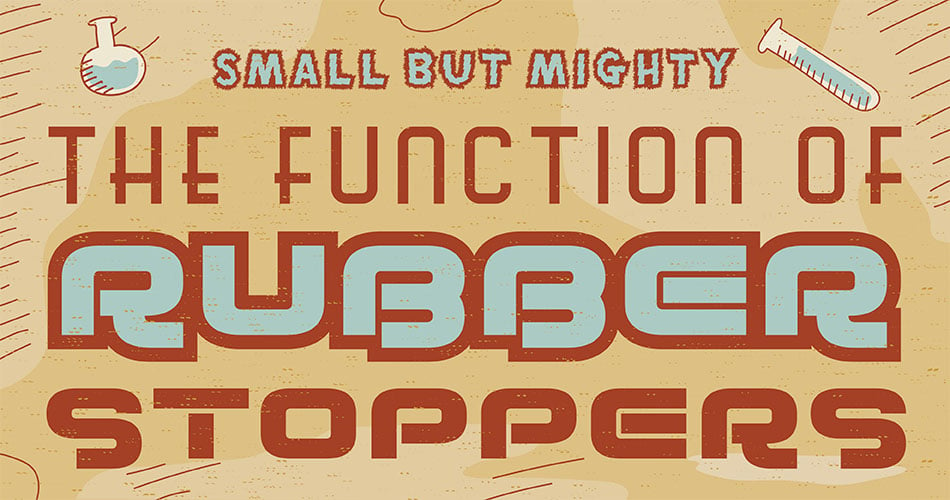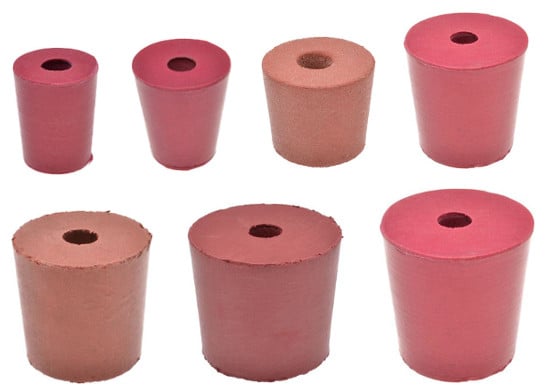Small but Mighty: The Function of Rubber Stoppers
May 25, 2023

Rubber stoppers. You have probably encountered them countless times without giving them much thought. These small yet mighty objects play a significant role in our lives. From the laboratory to the kitchen, their versatile functionality says it all.
Even so, these essential components often go unnoticed — but not anymore! This blog will unveil the diverse functions and applications of rubber stoppers. Get ready to see these humble but powerful objects in a whole new light!
Rubber Stoppers
When you think about it, rubber stoppers are everywhere. They seal the openings of test tubes in the lab for accurate results. Or secure the freshness and flavour of your favourite beverages. They even safeguard the potency of medications to preserve effectiveness, and — overall:
- maintain airtight seals
- prevent leaks and spills
- protect the contents they enclose
But what are they, really?
Rubber stoppers can create a tight and secure seal in various applications. They are typically small, cylindrical plugs made from rubber or elastomeric materials. Their size is designed to fit into the openings of containers, tubes, or other objects.
The structure can vary depending on their specific purpose. Generally, they consist of a solid, dense core with a tapered or cylindrical shape. This allows them to fit securely into the opening they are intended for. The outer surface of the stopper is often smooth for easy insertion and removal. The inner surface, in contrast, may be ribbed or fluted to enhance the sealing ability.
As for the materials, the stoppers are usually made of:
- natural rubber (latex)
- synthetic rubber (silicone, neoprene, or butyl rubber)
- a combination of both
The choice of material depends on the specific application requirements. Also, factors like chemical resistance, temperature resistance, flexibility, and durability.
The working principle
Rubber stoppers create a tight seal when inserted into an opening. They work by forming a physical barrier that blocks the passage in and out of a container. When pressed or inserted into a container or tube, it exerts an outward pressure. This effectively seals the space against the walls of the opening. And this pressure helps to create an airtight or liquid-tight seal.
This sealing ability is crucial in a wide range of applications. In medical settings, the stoppers maintain the sterility and integrity of medications. In industrial settings, they help prevent leaks, spills, and so on.
The Top Uses of Rubber Stoppers
Rubber stoppers have a wide range of applications across various industries and settings. Their versatility and sealing properties make up for this. Here are some examples of their uses, from laboratory to household settings:
1. Laboratory use
Rubber stoppers play a crucial role in laboratories. Their function is to create airtight seals for various equipment, including:
- Test tubes. Rubber stoppers fit securely into the openings of test tubes. They ensure a tight seal that prevents leaks during experiments or storage.
- Erlenmeyer flasks. Paired with a stopper, scientists can safely mix, heat, or store substances. They can do so effectively without the risk of contamination or evaporation.
- Separatory funnels. Such stoppers with tapered ends are employed to seal separatory funnels. This allows for controlled liquid extraction and separation processes.
If you are looking for one, check out these chemical-resistant rubber stoppers!
They come in with 1 or 2 holes ranging in size from 16 to 32mm and are suitable for almost all general laboratory uses.
2. Medical and pharmaceutical use
In these fields, stoppers maintain the integrity and sterility of containers. Examples include the following:
- Medication bottles. The tiny stoppers prevent air and moisture from entering the bottles. This ensures the longevity and effectiveness of the enclosed medications.
- Vaccine vials. For maintaining a sterile environment and protecting the vaccines from contamination. The stoppers also safeguard their potency and safety.
3. Industrial use
Rubber stoppers find applications in industrial settings where sealing and containment are crucial.
- Bottling industry. The stoppers seal bottles containing beverages or liquids. This helps prevent leakage, preserve carbonation, and maintain freshness.
- Chemical industry. For sealing containers to ensure a secure barrier against spills, leaks, or evaporation.
- Manufacturing processes. It may be employed in machinery to seal access points or create airtight connections. This prevents the escape of gases or fluids.
4. Household use
Rubber stoppers also have practical applications in everyday household items, such as:
- Kitchenware. Rubber stoppers seal containers such as food storage jars or bottles. They help to preserve the freshness and quality of ingredients or leftovers.
- Bathtub or sink stoppers. For blocking the drain openings in bathtubs or sinks.
- Furniture floor protectors. Usually with protective pads and attached to furniture legs. This helps prevent scratches on floors and provides stability
Different Types of Rubber Stoppers
There are different types of rubber stoppers available on the market. Each type meets specific requirements and applications, and these are:

Solid rubber stoppers
These stoppers are made of solid rubber and are used for general sealing purposes. They provide a tight seal and are available in various sizes to fit different openings.

Two-hole rubber stoppers
As the name suggests, these stoppers have two holes drilled through them. They come in handy in lab use, where tubes or probes need to be inserted through the stopper while maintaining a seal. The holes allow for the passage of instruments or tubing.

One-hole rubber stoppers
Similar to two-hole stoppers, these stoppers have a single hole drilled through them. They are used when only one tube or probe needs to be inserted through the stopper while maintaining a seal.
Self-sealing rubber stoppers
These stoppers are have a special valve or slit. This feature enables the insertion of syringes, needles, or tubing. The self-sealing mechanism helps maintain a seal around the inserted object.
Lyophilisation stoppers
Lyophilisation is a process used in the pharmaceutical and biotechnology industries. For this type of stopper, it is specially designed to withstand extreme temperatures. Moreover, it holds out the vacuum conditions of the freeze-drying process. They ensure a secure seal and maintain the integrity of the lyophilised product.
Tapered rubber stoppers
Tapered stoppers have a cone-shaped design, gradually narrowing towards the bottom. This shape allows them to fit into various-sized openings, providing a tight seal. They are ideal in lab glassware or other containers with conical or tapered necks.
Specialised rubber stoppers
There are rubber stoppers with unique features or materials tailored for particular industries. For example, high-temperature-resistant stoppers. They are used in applications where elevated temperatures are involved. Another is the chemical-resistant ones designed to withstand exposure to corrosive substances.
The choice of the appropriate type of stopper depends on factors such as:
- the application
- container size and shape
- sealing requirements
- and any specialised needs related to temperature, chemicals, or insertion of instruments
The availability may also vary depending on the supplier, industry, or specific requirements.
The Bottom Lines
Rubber stoppers have proven themselves again, serving as barriers against contamination and leakage. They may be small in size, but their impact and functionality are mighty. They are an unsung hero in our quest for precision, reliability, and safety. So, the next time you encounter a rubber stopper, take a moment to appreciate its role and impact!
© Electrotech Brands Pty Ltd 2023


Write a Comment
You must be logged in to post a comment.